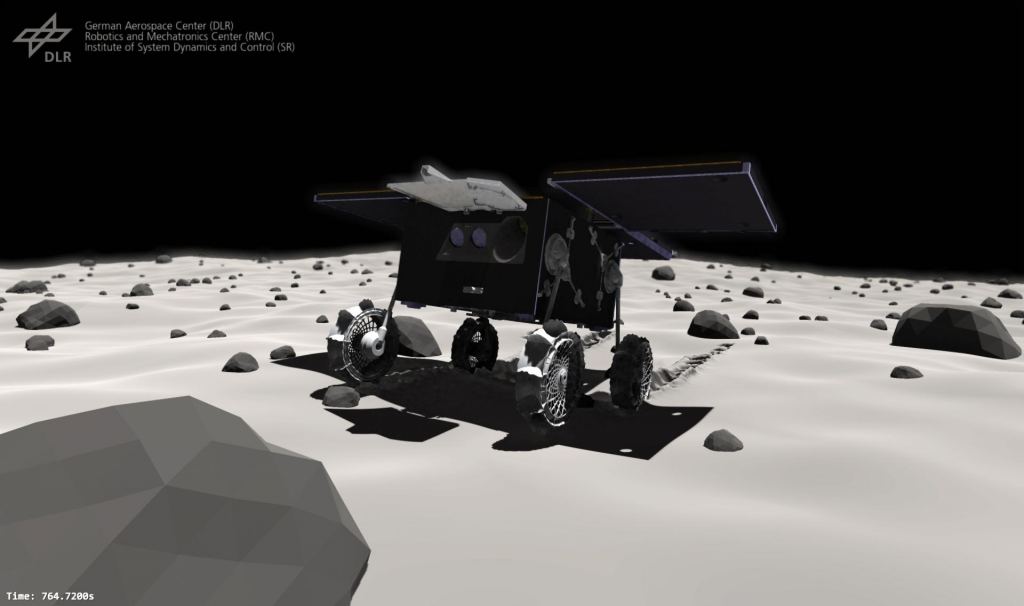Rovers seem to be proliferating all over Mars. There are currently 4 on the surface, and another (Perseverance) will be arriving in a few months after a successful launch at the end of July. Mars itself isn’t the only interesting rocky body in the Martian system, however. Its two moons, Phobos and Deimos, pose a bit of a mystery. How were they formed? Were they captured asteroids or caused by an impact similar to Earth’s own Moon?
Scientists and engineers are now one step closer to answering those questions with the successful test of a rover that will visit Phobos with JAXA’s Martian Moon Exploration (MMX) mission that will launch in 2024. The rover, which has yet to be separately named from its parent mission, just underwent some testing that will help to prove it’s worthy to join the pantheon of rovers roaming around the Martian system.
This round of testing focused on what engineers would call “shock & vibe”. The plan is to drop the rover in a free fall of about 40 to 100 meters onto the surface of Phobos. With any planet size object, most rover would be crushed. But since the gravity of Phobos is only two thousandths that of Earth, this rover would only be subjected to the force of a 5 cm drop at Earth gravity.

Credit: DLR
That does not mean such a drop would be easy on the rover though. Weight is a huge constraint for all space missions. Given that constraint, the rover is expected to weigh in at approximately 25 kilograms. That weight has to include all the scientific instrumentation as well as the drive train and rover body that would have to absorb any landing shock.

Credit: DLR
In order to lightweight the rover’s 47.5-by-55-by-27.5 cm frame, engineers have designed a structure that is made up of aluminium honeycombs on the inside, but encased in an outer layer of carbon-fiber reinforced polymers. The model used for testing already uses this reinforced structure as its base.

Credit: DLR
That structure could potentially be subjected to some unexpected forces. There is no guarantee that the rover will land on its wheels after its freefall. In order to right itself, engineers have developed a mechanism that “will bring it into a position where it can autonomously move into the final driving orientation and deploy its solar panels.” says the project manager for German Aerospace Center (DLR), Markus Grebenstein.
The rover, which is a joint development between DLR and France’s Centre National d’Etudes Spatiales (CNES), who will handle the camera systems and on board computers, while DLR handles the drive trains and two of the scientific instruments in the payload (a radiometer and Raman spectrometer).
The scientific payload developed by these two European agencies was not yet delivered as a part of this round of testing. However, there will be additional testing rounds in 2021. These tests will focus on a structural model that has additional components in it, including the self-righting system. Additionally, the rover will be subjected to environmental testing which will mimic the extreme temperature fluctuations of -150 to +50 °C that happen on Phobos’ surface over the course of a seven hour day/night cycle.
This is not the first time these agencies have paired up with JAXA to operate in such extreme environments before. DLR and CNES jointly developed the MASCOT system, which took some amazing pictures of the asteroid Ryugu while landing on it as part of the Hyabusa2 mission. Landing a new rover on Phobos won’t necessarily be easier than landing on an asteroid. But if all testing and development goes well, we could see a new rover join the crowd in the Martian system in late 2026 or early 2027.
Learn More:
DLR – First tests for landing the Martian Moons eXploration Rover
Mars Daily – A Rover for Phobos and Deimos
Planetary Society – Meet MMX, Japan’s sample return mission to Phobos
Headline Image: Preparing the model rover for a drop test. Credit: DLR

